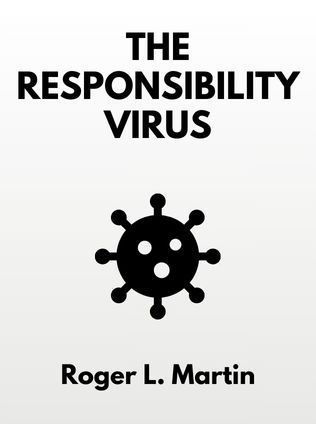
The Responsibility Virus
How Control Freaks, Mother Hens, Shrinking Violets and Yes-Men Can Harness the Power of True Partnership
By Roger L. Martin
Published 12/2003
About the Author
Roger Martin, the Dean of the Rotman School of Management at the University of Toronto, is a prolific thinker and writer in the field of management and leadership. With a career spanning over three decades, Martin has consistently offered deep insights into the dynamics of corporate behavior and leadership. His work has been featured in esteemed publications such as The Financial Times, The Globe and Mail, and Fast Company. Prior to his academic tenure, Martin was a consultant with the Monitor Company for 13 years, where he honed his expertise in strategic thinking and organizational development. His book, "The Responsibility Virus," delves into the intricacies of leadership and followership, presenting a compelling analysis of how fear of failure can cripple organizational effectiveness.
Main Idea
In "The Responsibility Virus," Roger Martin explores a pervasive issue in organizations where individuals either assume too much responsibility or too little, leading to dysfunctional dynamics and organizational inefficiency. This phenomenon, which Martin dubs the Responsibility Virus, stems from a deep-seated fear of failure. Heroic leaders take on excessive responsibility, believing their followers are incapable, while passive followers cede responsibility, sensing it is being taken away from them. This cyclical behavior results in a lack of true collaboration and productivity. Martin offers practical tools and strategies to break free from this destructive cycle and foster a culture of genuine partnership and shared responsibility.
Table of Contents
- Dynamics of the Responsibility Virus
- Costs of the Responsibility Virus
- Tools for Inoculating Against the Virus
- The Challenge Facing Professionals and Directors
Dynamics of the Responsibility Virus
The Responsibility Virus is vividly illustrated through the story of Michael, the new publisher of Wapshot magazine, and Caroline, a dynamic sales executive he hires. Michael's panic-driven takeover of Caroline's responsibility during a crucial presentation sets off a chain reaction. His assumption of control leads to Caroline's diminishing confidence and increased dependence on him. This creates a vicious cycle where Michael becomes overburdened and Caroline feels undermined, ultimately jeopardizing the magazine's success.
Martin explains that the fear of failure is a primary driver of the Responsibility Virus. Individuals adopt one of two primitive responses: "fight" or "flight." Those who fight seize control, believing they alone can ensure success. Conversely, those who flee relinquish responsibility, doubting their capabilities. This dynamic is further compounded by governing values such as the need to win, maintain control, avoid embarrassment, and stay rational. These values, rooted in fear, dictate our interactions and perpetuate the cycle of over-responsibility and under-responsibility.
Role of the Fear of Failure
Fear of failure often leads to the very failure we seek to avoid. This fear manifests in actions driven by the need to maintain control and avoid embarrassment. The over-responsible individual takes on too much, believing others cannot handle the task, while the under-responsible individual withdraws further, feeling their contribution is undervalued. This creates a static and dynamic conservation of responsibility, where the balance of responsibility shifts between individuals or within an individual over time, but the overall burden remains the same.
Static and Dynamic Conservation of Responsibility
The law of Conservation of Responsibility, inspired by thermodynamics, suggests that responsibility within an organization is neither created nor destroyed, only transferred. In static conservation, one individual's over-responsibility directly correlates with another's under-responsibility at a given moment. Dynamic conservation occurs within an individual over time, as initial over-responsibility leads to eventual burnout and under-responsibility, necessitating others to step up. This cyclical pattern perpetuates the Responsibility Virus, undermining long-term organizational success.
Costs of the Responsibility Virus
The Responsibility Virus incurs significant costs, primarily by undermining genuine collaboration, fostering mistrust and misunderstanding, and causing the atrophy of choice-making skills.
The Death of Collaboration
True collaboration requires sharing meaningful responsibility and engaging in productive dialogue. However, the Responsibility Virus disrupts this process. Over-responsible individuals monopolize control, fearing failure if they delegate. This discourages under-responsible individuals from contributing, further entrenching the cycle. The result is a lack of collaboration, which hinders organizational growth and innovation. Companies fail to leverage the collective intelligence of their teams, leading to suboptimal outcomes.
Sign up for FREE and get access to 1,400+ books summaries.
You May Also Like
The Subtle Art of Not Giving a F*ck
A Counterintuitive Approach to Living a Good Life
By Mark MansonRich Dad Poor Dad
What the Rich Teach Their Kids About Money - That the Poor and Middle Class Do Not!
By Robert T. KiyosakiHow To Win Friends and Influence People
The All-Time Classic Manual Of People Skills
By Dale CarnegieQuiet: The Power of Introverts
The Power of Introverts in a World That Can't Stop Talking
By Susan Cain



















